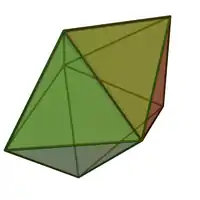Pentagonal bipyramid
In geometry, the pentagonal bipyramid (or dipyramid) is third of the infinite set of face-transitive bipyramids. Each bipyramid is the dual of a uniform prism.
| Pentagonal bipyramid | |
|---|---|
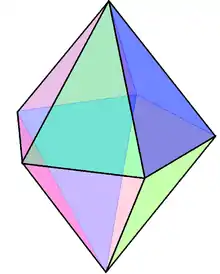 | |
| Type | Bipyramid and Johnson J12 - J13 - J14 |
| Faces | 10 triangles |
| Edges | 15 |
| Vertices | 7 |
| Schläfli symbol | { } + {5} |
| Coxeter diagram | |
| Symmetry group | D5h, [5,2], (*225), order 20 |
| Rotation group | D5, [5,2]+, (225), order 10 |
| Dual polyhedron | pentagonal prism |
| Face configuration | V4.4.5 |
| Properties | convex, face-transitive, (deltahedron) |

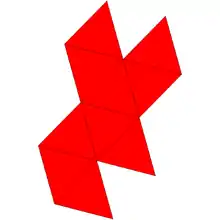
Although it is face-transitive, it is not a Platonic solid because some vertices have four faces meeting and others have five faces.
Properties
If the faces are equilateral triangles, it is a deltahedron and a Johnson solid (J13). It can be seen as two pentagonal pyramids (J2) connected by their bases.
A Johnson solid is one of 92 strictly convex polyhedra that is composed of regular polygon faces but are not uniform polyhedra (that is, they are not Platonic solids, Archimedean solids, prisms, or antiprisms). They were named by Norman Johnson, who first listed these polyhedra in 1966.[1]
The pentagonal dipyramid is 4-connected, meaning that it takes the removal of four vertices to disconnect the remaining vertices. It is one of only four 4-connected simplicial well-covered polyhedra, meaning that all of the maximal independent sets of its vertices have the same size. The other three polyhedra with this property are the regular octahedron, the snub disphenoid, and an irregular polyhedron with 12 vertices and 20 triangular faces.[2]
Formulae
The following formulae for the height (), surface area () and volume () can be used if all faces are regular, with edge length :[3]
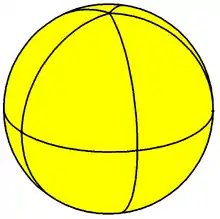
Related polyhedra
The pentagonal bipyramid, dt{2,5}, can be in sequence rectified, rdt{2,5}, truncated, trdt{2,5} and alternated (snubbed), srdt{2,5}:
The dual of the Johnson solid pentagonal bipyramid is the pentagonal prism, with 7 faces: 5 rectangular faces and 2 pentagons.
| Dual pentagonal bipyramid | Net of dual |
|---|---|
 |
 |
See also
| Name | Digonal bipyramid | Triangular bipyramid (J12) | Square bipyramid (O) | Pentagonal bipyramid (J13) | Hexagonal bipyramid | Heptagonal bipyramid | Octagonal bipyramid | Enneagonal bipyramid | Decagonal bipyramid | ... | Apeirogonal bipyramid |
|---|---|---|---|---|---|---|---|---|---|---|---|
| Polyhedron image |  |
 |
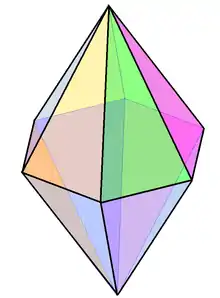 |
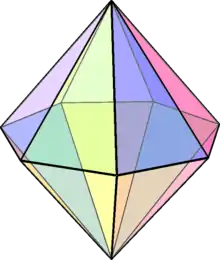 |
 |
 |
... | ||||
| Spherical tiling image |  |
 |
 |
 |
 |
 |
 |
Plane tiling image | |||
| Face configuration | V2.4.4 | V3.4.4 | V4.4.4 | V5.4.4 | V6.4.4 | V7.4.4 | V8.4.4 | V9.4.4 | V10.4.4 | ... | V∞.4.4 |
| Coxeter diagram | ... |
References
- Johnson, Norman W. (1966), "Convex polyhedra with regular faces", Canadian Journal of Mathematics, 18: 169–200, doi:10.4153/cjm-1966-021-8, MR 0185507, Zbl 0132.14603.
- Finbow, Arthur S.; Hartnell, Bert L.; Nowakowski, Richard J.; Plummer, Michael D. (2010), "On well-covered triangulations. III", Discrete Applied Mathematics, 158 (8): 894–912, doi:10.1016/j.dam.2009.08.002, MR 2602814.
- Sapiña, R. "Area and volume of the Johnson solid J₁₃". Problemas y ecuaciones (in Spanish). ISSN 2659-9899. Retrieved 2020-09-04.
